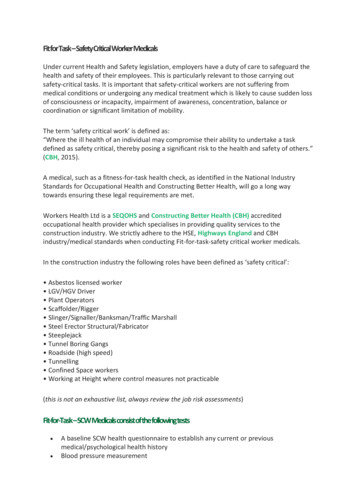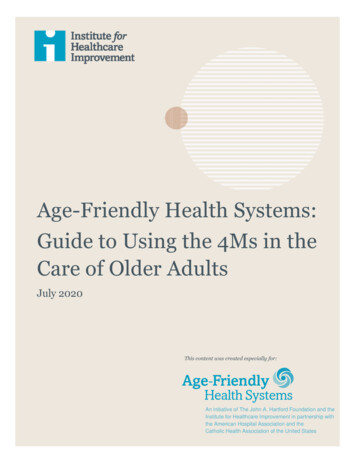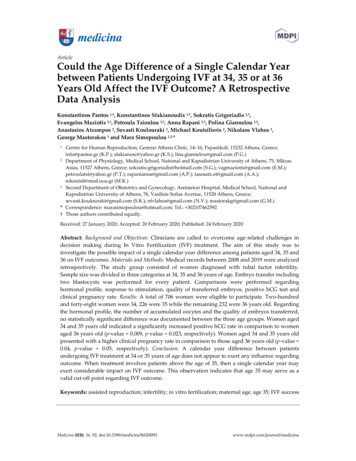
Transcription
Age-friendly bankingWhat it is and how you do it
About Age UKAge UK is the country’s largest charity dedicatedto helping everyone make the most of later life.We believe in a world where everyone can lovelater life and we work every day to achieve this.We help more than 5 million people every year,providing support, companionship and advicefor older people who need it most. The Age UKnetwork includes Age UK, Age Cymru, Age NIand Age Scotland and around 165 local Age UKpartners in England. Learn more atwww.ageuk.org.ukAbout AARPAARP is a US-based nonprofit, nonpartisanorganisation, with a membership of nearly38 million, that helps people turn their goalsand dreams into real possibilities, strengthenscommunities and fights for the issues that mattermost to families such as healthcare, employmentand income security, retirement planning,affordable utilities and protection from financialabuse. The AARP Foundation is an affiliatedcharity that provides security, protection, andempowerment to older persons in need withsupport from thousands of volunteers, donors,and sponsors. AARP has staffed offices in all50 US states, the District of Columbia, Puerto Rico,and the U.S. Virgin Islands. Learn more atwww.aarp.org2ContentsForeword41. Introduction – what is age-friendly banking?62. What older people tell us about theirbanking experiences103. Age-friendly banking in pictures144. Agenda for innovation in age-friendly banking164.1 Detecting and stopping financial scams174.2 Enabling caregivers to assist with banking 224.3 Accessible branch banking274.4 Designing banking servicesto be age-friendly304.5 Better call handling systems334.6 Responding to customer vulnerability354.7 Age-friendly products375. Age-friendly banking checklist386. Further reading on age-friendly banking427. Acknowledgements43
Index of case studiesCase Study 1: Coventry Building Society – helping customersavoid scams18Case Study 2: First Financial Bank (Texas, USA) –‘Fraud Busters’, a three-pronged approach to preventing fraud20Case Study 3: Oregon Bankers Association toolkiton preventing exploitation21Case Study 4: Lloyds Banking Group –system for registering Power of Attorney23Case Study 5: Barclays Bank – Carer Forums24Case Study 6: Wells Fargo Advisors (USA) – Elder Strategy Group25Case Study 7: Bank of American Fork (Utah, USA) – preventing abusethrough an age-friendly culture26Case Study 8: RBS and NatWest – mobile bank branches28Case Study 9: RBS and NatWest – accessible debitand savings cards31Case Study 10: Nationwide Building Society – Helping Hand unit31Case Study 11: Cheque and Credit Clearing Companyand Barclays Bank – electronic cheque imaging32Case Study 12: RBS and NatWest – removing targetcall handling times34Case Study 13: Santander – vulnerable customersawareness training363
Foreword by Age UKFor a number of years, Age UK has taken a close interestin matters to do with money management and banking,as these are central to the convenience of everyday livingand financial planning for later life. Older people contact usregularly to describe the challenges they have faced withmortgages, loans, insurance, benefits, debt, payments andday-to-day transactional banking. With the rapid growthof the population aged 80 , the issue of carer bankingis also very important – not only full Power of Attorney,but a portfolio of carer financial options, attuned to theparticular needs of the individual and permitting as muchindependence and self-reliance as possible.Technological change brings both challenges and opportunities. In 2014UK non-cash payments exceeded cash payments by volume for the firsttime. New technology holds out the promise of better, cheaper services– but only if a sufficient range of well-designed options is available for aconsumer marketplace with a very diverse range of needs. The fast paceof change is difficult for many people to adjust to. Bank branch closures,for example can be particularly challenging for socially or digitallyexcluded older people. New technologies bring convenience, but alsonew opportunities for fraud and scams.There are many challenges, but we have also been heartened to seeinnovations by financial providers towards better customer service. Thisreport highlights examples from the UK and the USA of what we call‘age-friendly banking’. We encourage every bank, building society andother financial service provider to put ‘age friendliness’ at the heart oftheir technical, financial and service propositions.Tom Wright CBE, Group Chief Executive of Age UK4
Foreword by AARPRegardless of age, health or economic circumstance, nearlyeveryone needs to bank. However, hearing, vision andmobility issues often arise as people age and can makecertain banking tasks such as reading statements, standingin line, and communicating with tellers more challenging.The impact is even more far-reaching. Family caregiversare often asked to help a friend or relative managefinances because of a decline in their loved one’s healthor cognitive ability.These challenges are compounded by the fact that thousands of peopleaged 50 become victims of financial exploitation every day. Not onlydo they lose money, but the loss of trust and dignity can have severeimpacts on their health and well-being. Older people are targeted notonly because they have built up a lifetime of savings, but also becausethose who suffer cognitive decline are more vulnerable to exploitation.We know if nothing changes the problem of financial exploitation willonly get worse as the number of older people and their assets continueto grow.AARP is tackling financial exploitation head on. But we know we cannotdo it alone. Financial institutions are in a unique position to help protectolder Americans before their savings leave their accounts. And consumersare asking for help. Our surveys found that eight out of ten olderAmericans want to establish their accounts at banks that are lookingout for their best interests by fighting exploitation and providingage-friendly services.By protecting and empowering their customers, AARP believes banks canminimise their own risk and exposure to losses from financial exploitationwhile increasing brand distinction, strengthening customer trust, andimproving employee morale.AARP is pleased to collaborate with Age UK on this report. As two of thelargest non-profits focused on ageing, we are bringing collective voiceto enhance and improve the lives of people as they age. With this paper,Age UK provides a cross-continental blueprint of proven solutions thatbanks use to fight exploitation and promote age-friendly services. Wehope more financial institutions will adopt similar solutions to help olderpersons manage and maintain their finances not just in the US and UK,but across the globe.Dr Debra Whitman, Chief Public Policy Officer, AARP5
1 Introduction6
Older people tell us about a range of challenges thatarise in using banking and payments systems. This reportdescribes some of these challenges and how banks in theUK and USA have begun to address them. The featured casestudies show that with thought, careful design and goodimplementation, significant progress can be made.What is age-friendly banking?By ‘age-friendly banking’ we mean banking services, products andfacilities that remain accessible and easy-to-use as people age, assistcaregivers and prevent financial exploitation.The best of UK and USA experienceThis report contains case studies gathered by AARP Public Policy Instituteand Age UK. AARP is a non-profit, non-partisan US organisation with amembership of nearly 38 million, dedicated to the needs and interestsof Americans aged 50 .1 Age UK is the leading UK charity addressingthe needs of older people. This report identifies banking issues faced byolder people in the UK and USA and features case studies of the waysUS and UK banks have sought to improve the service they give to theolder population. We encourage banks to examine the needs of theircustomers and adopt the best practices appropriate to these needs.What challenges do customers face as they age?Older people are highly diverse. Some of us remain fit, healthy, mobileand abreast of digital technology until the end of our lives. Others ofus face increasing challenges as we age: we may be less mobile orlive further away from the services we need; we may have physicaldisabilities including deterioration of sight and hearing or arthritis in thehands; we may be offline because of the relatively recent arrival of theInternet and/or the cost of computers and connections; our incomemay be low or have fallen compared with what we had in paid work;we may find it hard to remember passwords and security codes or havetrouble with call centre menus; some of us live with cognitive decline andbecome dependent on carers to assist with our banking.1 www.aarp.org2 Oxford Economics, The Longevity Economy– Generating economic growth and newopportunities for business, 2015, p 4.3 Age UK, Agenda for Later Life 2015, p 7.Nevertheless, we remain customers of banks, we need to manage ourmoney and some of us have substantial financial resources. Older peopleare a substantial part of the economy in the USA and UK and essentialcustomers for the banking industry. In the USA, the ‘longevity economy’(economic activity arising from the spending of those aged 50 ) in2012 amounted to US 7.1 trillion.2 In the UK in 2013, those aged 65 accounted for household spending of 145 billion.37
Excellent service for allOne of the insights of age-friendly banking is thatif a bank can provide good service for its oldestcustomers, it can provide excellent service for all.The young and the middle-aged navigate the samesystems as older people, but may have greaterresilience in coping with poor design – for example,being able to access bank services through alternativechannels. A bank that improves its systems andservices to assist its older customers is likely to find therest of its customers delighted by the improvement.Why become an age-friendly bank?From our discussions with banks in the UK and USA,we hear several reasons for becoming age-friendly,which together make a powerful business case: To adapt to the needs of an ageing society. To deliver a better service to existing and newcustomers and improve customer satisfaction. To build a reputation for age-friendly service thatmay give competitive advantage. To develop systems and products that better suitall customers, regardless of age. To reduce fraud and financial exploitation. To improve the relationship of the bank withits stakeholders. To help rebuild the reputation of the banking sectorfollowing the crash of 2008. To meet obligations under equality and humanrights legislation.8
Keys to creating an age-friendly bankCreating an age-friendly bank is about customer service, physical design,systems and products. It is also about the overall way in which a bankor building society thinks about itself as an organisation in relation toits customers, including being aware (through equalities monitoring)of exactly who its customers are.Customer service – make sure that staff are trained to recognise thespecific needs of older people, to listen to what older customers say tothem and to respond appropriately; ensure that front-line staff have thenecessary back-up to respond appropriately to unusual requests andsituations of vulnerability, especially relating to cognitive decline, scamsand financial abuse.Physical design – design branches to be easily accessible; arrangesuitable alternative physical services where the core branch networkis absent; design physical interfaces (ATMs, phones, computers, tablets,mobiles) to be accessible to people with as diverse a range of abilitiesas possible, with specialist back-up where needed. Ensure all customersknow about accessibility options, not just those who ask.Systems – make sure information is handled reliably and processes (callcentres, branches, postal, Internet and mobile) are carried out in waysthat meet the needs of older customers. Deliver better overall reliabilityby offering a range of access channels.Products – remove arbitrary age limits and design financial productsto fit the shape of later life.How a bank sees itself – like other large businesses, a bank is acommunity of stakeholders with a variety of interests, situated within alarger society. The more a bank sees itself as interdependent with thatlarger society and with responsibilities to all its stakeholders, the easierit will be for the bank to adopt practices that are friendly to older people.9
2 What older peopletell us about theirbanking experiencesLISTENChequeINTERNETOlderCall centrePHONEBRANCHSecuritySTATEMENTSSpeak clearlyATM10PEOPLEElectronic
As the largest UK charity addressing the needs of olderpeople, Age UK hears about the banking experiences ofolder people from a range of sources: letters and emails,calls to our national enquiry line, feedback from local Age UKpartners, commissioned surveys, forums and workshops. Wehave summarised and published these reports a number oftimes, for example in The Way We Pay (2011) and FinancialResilience in Later Life (2014). For the purposes of this reportwe supplemented our knowledge by running two workshopson age-friendly banking, one in Leicester (August 2015) andthe other in Abergavenny (September 2015) to make surethe reactions we report are as up-to-date as possible.From these sources, including the latest workshops, a consistent pictureemerges. Older people have a mix of positive and negative experienceswith their banks and building societies, and while different organisationsmay behave differently in similar circumstances (not all banks are equallygood or bad) there is a striking similarity in reported challenges andpreferences. Here we highlight the key messages.Banking is often a non-exclusive relationshipIn our workshops, most participants had at least two banks,4 some hadthree or four. People caring for others or looking after clubs or societieshad additional banking relationships. Often banking relationships aresplit by function. For example, a person may have their current accountwith one bank, savings accounts with one or more others and theircredit card with a different bank again. Banks therefore should think interms of having a shared customer base which, with retrenchment ofthe traditional branch network, could be served by shared solutions tocustomer needs, including shared branches.Many older people have a strong preferencefor in-branch banking4 The Social Market Foundation reports that20% of UK adults actively use more than onecurrent account provider, 50% of UK adultsactively use financial products from morethan one bank and 43% of all savings productsare with a provider the customer does nothave a current account with. Evans K, Playingthe Field – Consumers and Competition inBanking, Social Market Foundation, July 2015.5 ONS reports that in 2013, 23% of those aged65 used Internet banking compared to 71%of those aged 25–34. ONS, Internet Access –Households and Individuals 2014, p 7.While a minority of older people use Internet banking5 and appreciate itsconvenience, most have a strong preference for in-branch banking. Wehave heard this message many times: ‘I like to deal with people faceto-face.’ ‘I feel more comfortable in a branch.’ ‘I don’t want to talk to amachine. I want to talk to a human being.’ Older people are sensitive tobranch design and want banks to keep the main branch functions on theground floor, avoid playing loud background music, provide assistancefor use of in-branch banking machines, manage queues and providecomfortable chairs to sit on while waiting. One workshop participant wasimpressed by visiting a branch where the branch manager worked at adesk in the customer area, immersed in the banking experience of thecustomers. Getting the design right improves user experience and mayattract new customers.11
Many older people are worried aboutInternet securityOlder people value some electronicpayments but still like chequesMany older people are concerned about the securityof Internet banking and Internet commerce in general:‘Internet purchases are scary – I wouldn’t do it.’ ‘I haveworries about the Internet.’ These concerns arise frompublicity about fraud and breaches of Internet securityand from older people doubting their own Internetskills.6 Many older people, including a majority ofpeople aged 75 and nearly four fifths of those aged75 in the ‘DE’ social groups are not on-line.7 In manyareas where older people live, the Internet is not yetreliable or fast enough for a good Internet experience:‘Sometimes it stops in mid-transaction and you haveto do it again.’ Workshop participants felt that theywere being pressured toward Internet banking anddid not like this. ‘I keep getting pressurised to move toInternet banking. They think you are something outof the ark if you don’t bank online but I don’t trust it.’A key aspect of age-friendly banking, therefore, is anaccessible multi-channel approach, with additionalsupport for older people who may want tobank online.Older people are generally positive about directdebits, standing orders and receiving their pensionsby electronic payment. These functions are seen aspositive extensions to traditional banking as theyautomate familiar banking transactions andsave time.Many older people are concerned aboutthe security of on-street ATMsOlder people (especially those aged 75 ) told usthey are concerned about the security of on-streetATMs, for example their PIN being seen, beingmugged, fearing that an ATM has been tamperedwith, not knowing what to do if they can’t get theircard out of the machine. They prefer using ATMs inmore protected areas, such as bank branches orsupermarkets, providing the ATM is user-friendly. Thispresents a challenge when banks wish to rely on ATMsafter closing branches and highlights a need to designmore secure ATM environments.Older people continue to like using cheques. Chequesare used to pay for household services, purchasesmade by mail and to give gifts to children andgrandchildren. They are also used as a backup, e.g. forcash withdrawal, if a person’s card is stopped for somereason. ‘You know where you are with cheques. Youknow the date you wrote it and who to and you cancheck it against your statement.’ Having a paper audittrail may be part of a conscious strategy to deal withfailing memory.Many older people like paper statementsEven if they accessed their accounts online, manyworkshop participants expressed a preference forpaper statements and particularly did not like whatwere seen as ‘sneaky’ ways of moving peopleto electronic statements such as having ahard-to-see tick box if they want to continuereceiving paper statements.Banks are praised when they handle difficultsituations wellWhen a bank responds well to a difficult life situation(e.g. bereavement) this is greatly appreciated. ‘Theywere brilliant’ said one participant about how a bankhad responded to the death of his wife. On the otherhand, if such situations are handled badly, people getupset and distressed: ‘You’re already upset and thismakes it worse.’ ‘I went to pieces in the branch.’‘It was horrendous.’People like systems that work properlyand efficiently6 Such concerns have been reported in formal research. See, for example,Damant J and Knapp M, What are the likely changes in society andtechnology which will impact upon the ability of older adults to maintainsocial networks of support? Foresight, Government Office for Science, attachment tworks.pdf7 Ofcom, 2014. 67% of people aged 75 were not on line, rising to78% of those aged 75 in the ‘DE’ social groups.12Banks were generally praised for their methodsfor dealing with lost or stolen cards, for credit cardsecurity and for aids to good banking such as sendingtext messages when an account is at risk of goinginto overdraft.
There is misunderstanding about bank policytoward large paymentsWorkshop participants reported meeting barriers tolarge payments, including having to produce extra IDor having to split a large payment into several smallerpayments in order to get it through. It may be thatthese barriers arise from anti-scam or anti-abusesystems operated by the banks, but if so, this was notunderstood by the participants. One person said hisbank had told him it was ‘government instructions’.Older people are angered by their savingsdefaulting to low interest rate accountsWorkshop participants objected to finding they hadnot been offered the latest deals and having to shoparound to get better interest rates. ‘Why do we haveto go online for better interest rates? Shouldn’t theybe for everyone – even if you don’t use the Internet?’Poor experiences of contacting banksby phoneFew of our participants reported using phone bankingand most did not like the experience of calling theirbank. This is because of menu systems, queuing,having to remember security information and poorquality interaction with call handlers. People alsodislike the fact that they cannot call their own branchbut have to go through a national call number. Theexception was a bank that has a policy of directingcalls to a regular named person rather than to a menusystem. This approach was praised by those that hadexperienced it.The importance of good communicationand careful listeningSecond only to the preference for in-branch banking,older people want to be listened to properly and forstaff to speak to them clearly: ‘Listen to what olderpeople have to say.’ ‘Listen more carefully whendealing with older people – speak clearly and slowly.’‘Be extra patient and speak clearly.’ ‘No patronising.’13
3 Age-friendlybanking in pictures14
Customercentred serviceListen carefully to what older people say, talk clearly withoutpatronising at a speed appropriate to the customer. Be awareof vulnerability including short and long-term issues.Preference forin-branch bankingEasy-access branches, accessible staff,mobile and shared-use branches.Personalisedcall centresQuick pick-up by human operators. Careful listening and cleartalking. Avoid upselling. Give appropriate advice about scams andfraud. Focus on providing the solution sought by the customer.Age-friendlydesignBranches, cards, machines, apps and processes designed to beage-friendly, taking account of age-related perceptual and motorissues. New technology to be tested by older users to ensureuser-friendliness.ATMs insafe placesATMs in bank branches, post offices, supermarkets and othersafe non-street places.Cheques, cash andpaper statementsEnsure paper-based instruments continue alongside new digitaltechnology. Cheque imaging enables normal cheque use tocontinue while processing is digitised.Good systemsEnsure information systems are designed well so that tasks suchas registering Powers of Attorney and reorganising accounts onthe death of a customer are completed reliably and quickly.Innovation in IDand securityBe flexible with ID requirements for customers without passportsor driving licences. Design new ways of ‘passing security’ that donot rely on passwords and remembering complex information.Age-friendlyproductsStop defaulting older customers to low interest accounts. Helppeople find the best interest rates easily. Remove blanket agelimits on financial products such as mortgages.Improved carerbankingProvide secure systems for carers that enable them to carry outbanking functions for the person cared for without breachingthe terms and conditions of accounts.Improved methodsof stoppingscams, fraud andfinancial abuseContinue to develop fraud and abuse detection systems.Improve education about the risk of fraud, including at the timeof a suspect transaction. Use short payment delays to allowcustomers time to have ‘second thoughts’ about scam payments.15
4 Agenda forinnovation inage-friendly banking16
The case studies featured in this reportshow the potential for age-friendly banking.Taken together, they demonstrate thata combination of technical innovation,systems innovation and staff training canmake a huge difference. Participants inAge UK workshops confirm this: when theirencounters with the banking system havegone well, they are delighted with the easeand helpfulness of the process.However, not every experience is good. There isvariation in practice between different banks orbuilding societies, and between different processesand staff members of the same bank. Banks freelyadmit they are at the beginning, rather than at theend, of the journey. This publication is optimistic.Rather than dwelling on shortcomings, we havechosen to show examples of success, with the aimof commending the banking sector for its efforts todate and encouraging further innovation and thewider spread of age-friendly service. If a bank is notmentioned in this publication, it does not necessarilyimply a lack of age-friendly practices, only thatwe may not have heard about the bank’sparticular examples.Based on the case studies and feedback fromolder people, an agenda for innovation emerges.This requires developments in business practice,technology, systems and customer service. We lookforward to working together with the banking industryto find the best solutions.4.1 Detecting andstopping financial scamsFinancial fraudsters use crafty techniquesto ensnare people, techniques that playto the particular vulnerabilities of targetedindividuals: a confident investor will beoffered praise and apparently enticinginvestment opportunities; a careful saverwill be told that her account has beencompromised and she needs to moveher life savings to a new, ‘safer’ account.Fraudsters pretend to be the police or thefraud department of the customer’s bankand use ‘social engineering’ techniquesincluding call-backs and security texts to conpeople into believing that they are bona fide.Experience shows that banks can help theircustomers avoid being defrauded by a combinationof anti-fraud tactics: Delivering high profile anti-fraud informationin branch, online and by phone. Using analytical software to identify suspecttransactions prior to processing. Training staff to spot scams, fraud and financialabuse as they happen. Communicating with customers to confirmor cancel suspect transactions. Giving scam awareness messages by phonein the course of a suspect transaction. Delaying suspect transactions for a short timeto enable customers to have ‘second thoughts’.8 Financial Ombudsman Service, Calling time on telephone fraud,July 2015, p 31.According to the Financial Ombudsman Service,20 per cent of its scam complainants realise withintwo hours that they have been scammed, and75 per cent realise within a day,8 so a shortdelay on suspect transfers is likely to be aneffective countermeasure.17
Case Study 1Coventry Building Society –helping customers avoid scamsOver the past 18 months to two years, the financial servicesindustry has seen a sharp rise in cases of customers beingvictims of scams. The amount lost from telephone scamsalone (also known as ‘vishing’) rose from 7 million in 2013to 13.9 million in 2014.9The Coventry Building Society (the Coventry) has responded with acombination of anti-fraud messaging, campaigns in branches, improvedstaff training and more sophisticated ways of reacting to scams asthey happen.Literature, website and telephone messagesTelephonescamsHelping you protect yourself against fraudThe Coventry introduced a printed anti-scams guide,a dedicated ‘Security’ area on the Society’s websiteand a number of anti-fraud messages that membershear when calling the Customer Service Centre. Themessages advise members what details a genuinecaller from the Coventry would and would not ask for,and what to do if they think they are being scammed.Anti-fraud campaigns in branchesTo reinforce the messages, the Coventry has run a ‘Protect yourself fromscams’ campaign to raise awareness of financial crime and promptcustomers to talk to staff to learn more. 13.9 millionlost from telephonescams alonein 2014.Everyone needsdefences.Find out how to protectyourself from fraud.18Learn more about how to protect yourselffrom fraud. Pick up a leaflet today.Coventry Building Society. Registered Office: Economic House, PO Box 9, High Street, Coventry CV1 5QN.Pick up a leaflet today.Coventry Building Society. Registered Office: Economic House, PO Box 9, High Street, Coventry CV1 5QN.25805 08/14 2014/nfp/2599 Financial Fraud Action UK,Fraud the Facts 2015, p 24.25806 08/14 2014/nfp/259Protect what’s yours.Because some thingsyou don’t want to share.
Staff trainingAnti-fraud training begins when new staff membersreceive Financial Crime training at their corporateinduction. This knowledge is refreshed each yearthrough an annual Financial Crime Focus Week,annual Financial Crime training and tailored trainingsessions when a need is identified – for example,if a new or lesser known financial scambecomes prevalent.Staff are trained to look for changes in a customer’sbehaviour or transaction patterns as a key sign thatthey could be victims of a scam. It can be particularlychallenging to identify this over the phone, sospecialised tactics have been developed.Reacting to scams as they happenThe Coventry has a specialist Financial Crime teamwhich is equipped with a range of tools and strategiesto help protect its members, such as contactingcustomers to discuss certain transactions, establishingwhether the customer has been the victim of a scamand acting accordingly.Case study: Mr Johnson*During routine checks, a member of the FinancialCrime Team was alerted to an unusual transfer on acustomer’s account – a significant sum was scheduledto be transferred to an account with a different bank.The Financial Crime Support Officer called the accountholder, Mr Johnson, to check that the transfer wasauthorised
50 US states, the District of Columbia, Puerto Rico, and the U.S. Virgin Islands. Learn more at www.aarp.org Contents Foreword 4 1. Introduction - what is age-friendly banking? 6 2. What older people tell us about their banking experiences 10 3. Age-friendly banking in pictures 14 4. Agenda for innovation in age-friendly banking 16










